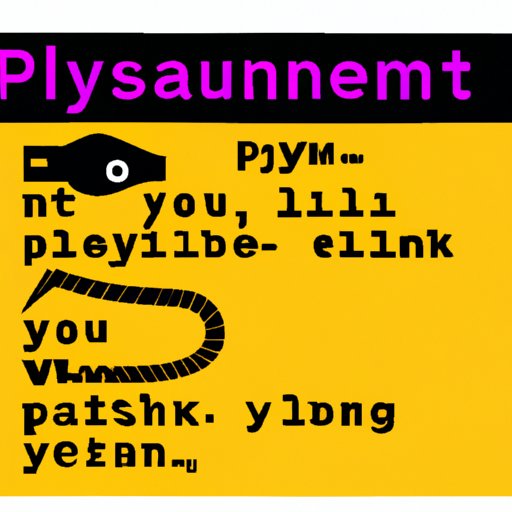Introduction
Python is a widely-used programming language that is becoming increasingly popular due to its versatility and ease of use. It can be used for everything from web development and data analysis to artificial intelligence and game development. One of the best ways to get started with Python is by using the terminal, which allows you to quickly and easily access the power of Python without having to install any additional software.
What is Python?
Python is an interpreted, high-level, general-purpose programming language. It was created in 1991 by Guido van Rossum and is now one of the most popular programming languages in the world. Python is known for its readability and simple syntax, making it a great choice for beginners. It is also highly versatile, and can be used for a variety of tasks, ranging from web development to data analysis.
Why Should You Use Python in Terminal?
Using Python in the terminal is a great way to get started with programming. It is quick and easy to set up, and you don’t need to install any additional software. The terminal also provides an interactive environment for testing and debugging code, which makes it an ideal choice for those just starting out with Python.
Step-by-Step Guide on How to Launch Python in Terminal
If you’re ready to start using Python in the terminal, here’s a step-by-step guide to get you started.
Installing Python
Before you can start using Python in the terminal, you will need to install it. The official Python website has detailed instructions on how to do this, but generally speaking, you can install Python on Windows, Mac, and Linux systems simply by downloading and running the appropriate installer.
Launching Python in Terminal
Once Python is installed, you can launch it in the terminal. On Windows, you can open the Command Prompt, type “python”, and press Enter. On Mac and Linux systems, you can open the Terminal, type “python”, and press Enter.

An Overview of the Basics of Running Python in Terminal
Now that you know how to launch Python in the terminal, let’s take a look at some of the basics of running Python in the terminal.
Basic Syntax and Structure
The first thing you should know about Python is its basic syntax and structure. Python uses whitespace to denote blocks of code, so lines that are indented further are considered part of the same block. Python also uses colons (:) to indicate the start of a new block.
Working with Variables
Variables are one of the most important concepts in programming, and they are essential for writing programs in Python. Variables are used to store values, and they can be used to refer to those values later in the program. In Python, variables must begin with a letter or underscore (_) and can contain letters, numbers, and underscores.
Executing Python Code in Terminal
Once you have written your Python code, you can execute it in the terminal. To do this, simply type “python” followed by the path to the file containing your code. For example, if your code is contained in a file called “my_script.py”, you would type “python my_script.py” and press Enter.

Tips and Tricks for Starting Python in Terminal
Now that you know the basics of running Python in the terminal, let’s look at some tips and tricks for getting the most out of Python in the terminal.
Making the Most of Python’s Terminal Features
Python has several features that make it easy to use in the terminal, such as tab completion and command history. Tab completion allows you to quickly complete commands by pressing the Tab key, while command history allows you to quickly view and execute previous commands.
Using Command Line Arguments
Command line arguments are another useful feature of Python in the terminal. Command line arguments allow you to pass information to your programs from the terminal. For example, you can use command line arguments to specify which files to open or which tasks to perform.
Troubleshooting Common Issues
When using Python in the terminal, you may encounter some common issues. These include syntax errors, incorrect paths, and missing modules. If you encounter any of these issues, the best course of action is to check the documentation and search online for help.

Exploring the Benefits of Using Python in Terminal
Using Python in the terminal comes with a number of benefits, including increased efficiency, easy debugging and development, and improved performance. Let’s take a closer look at each of these benefits.
Increased Efficiency
Using Python in the terminal allows you to quickly and easily execute code without having to write, compile, and run a program every time. This makes it easier to test and debug code, resulting in increased efficiency.
Easy Debugging and Development
Debugging and developing code in the terminal is much easier than in a graphical user interface. The terminal provides an interactive environment where you can quickly test and modify code, making it an ideal choice for developers.
Improved Performance
Using Python in the terminal can also improve performance. By eliminating the overhead associated with graphical user interfaces, Python can execute code faster in the terminal, resulting in improved performance.
A Comprehensive Guide to Launching Python in Terminal
This guide has provided an overview of how to launch Python in the terminal, but there’s still more to learn. Here are some additional tips for getting started with Python in the terminal.
Setting Up Your Environment
Before you can start writing and executing code, you need to set up your environment. This involves installing additional packages, such as the Python development tools, as well as configuring your system to use the correct version of Python.
Creating and Running Python Scripts
Once your environment is set up, you can start creating and running Python scripts. To do this, you’ll need to create a text editor and save your script as a .py file. You can then run your script in the terminal by typing “python” followed by the name of the file.
Viewing and Editing Files
You can also use the terminal to view and edit files. To view a file, type “cat” followed by the name of the file. To edit a file, type “nano” followed by the name of the file.
Working with Python Libraries
Finally, you can also use the terminal to work with Python libraries. Python libraries are collections of code that can be used to extend the functionality of your programs. To install a library, type “pip install” followed by the name of the library.
Conclusion
Launching Python in the terminal is a great way to get started with programming. It is quick and easy to set up, and provides an interactive environment for testing and debugging code. With the tips and tricks outlined in this guide, you’ll be well on your way to mastering Python in the terminal.
(Note: Is this article not meeting your expectations? Do you have knowledge or insights to share? Unlock new opportunities and expand your reach by joining our authors team. Click Registration to join us and share your expertise with our readers.)
